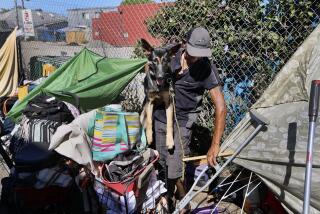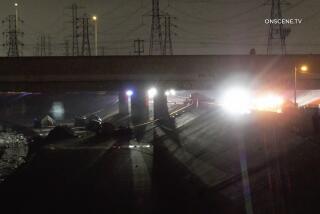Little progress in homicide probe
Despite a three-month investigation that has taken police into the underworld of the chronically homeless, homicide detectives said they do not have any suspects or a motive in the November slayings of five people at an encampment in the shadow of two Long Beach freeways.
As the weeks drag on with one false lead after another collapsing, forensic analysts have yet to finish processing hundreds of pieces of evidence -- clothing, splattered blood, fingerprints, a bicycle -- collected at the victims’ tarp-covered hideaway beneath low-hanging bottlebrush trees along the Santa Fe Avenue offramp of the 405 Freeway.
The bullet-riddled bodies of three men and two women were discovered Nov. 2 after an anonymous tipster called police with a terse message: “There’s five bodies over by Santa Fe and Wardlow.”
Police quickly tracked down the tipster, but that person is not a suspect in the case, said Long Beach Police Lt. Lloyd Cox.
Complicating the investigation, police have encountered obstacles particular to the rhythms of life among the estimated 1,100 chronically homeless men and women believed to live in freeway crawl spaces, crude shelters and scraggy stretches of underbrush in the Los Angeles River corridor.
There were no neighbors to interview. Many denizens of the secretive network of homeless encampments are wary of outsiders. Some expressed grave concerns about their personal safety if they were to be seen talking to police.
“We have two detectives working full time on this case, following every small lead that comes up,” Sgt. Eric Herzog said. “They’ve become experts on the homeless, and the region’s whole separate society of homeless camps.”
“Every homicide case is challenging,” he said. “This case presents challenges all its own.”
The Los Angeles County Board of Supervisors, at the request of Supervisor Don Knabe, a week ago renewed a $20,000 reward for information leading to the arrest and conviction of the person or persons responsible.
“Twenty-thousand dollars could keep a homeless person off the street for quite a while,” Cox said. “But it hasn’t been a big incentive in this case. So far, it hasn’t worked.”
Susan Price, homeless services officer with the Long Beach Department of Health and Human Services, offered a possible reason for that.
“This incident resonated powerfully within the homeless culture,” Price said.
“It forced people who live without four walls around them to take a harder look at the fine line between self-protection and relying on others to survive,” she said.
Within hours of the tip, authorities combed through evidence at the secluded encampment -- an assemblage of heavy rugs, fast-food wrappers, blankets and clothing -- at the base of the freeway embankment with only one way in and out.
The victims were Vanessa Malaepule, 34; her boyfriend Lorenzo Perez Villacana, 44, who lived at the camp; Katherine Verdun, 24; Hamid “Sammy” Shraifat, 41; and Frederick Neumeier, 53.
Authorities believe all five, including Malaepule, who was an unemployed single mother of six -- ages 8, 10, 13, 14, 15 and 16 at the time -- were friends and had been socializing with one another for some time.
A day after they were gunned down, more than a dozen relatives of Malaepule gathered at the dank, cave-like encampment to light candles and pray. One of them suggested Malaepule’s relationship with Villacana led her to be “in the wrong place at the wrong time.”
“Initially, we received more than 30 phone calls,” Cox said. “But most were from people wanting to know the identities of the victims. There were few leads.”
“But this case is by no means over,” Herzog said. “We have some positive information that we are following up on. We hope it leads us to a suspect soon.”
--
More to Read
Sign up for Essential California
The most important California stories and recommendations in your inbox every morning.
You may occasionally receive promotional content from the Los Angeles Times.










